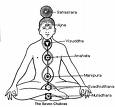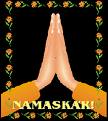Sanskrit Words Used in Class
 A’sana: Literally meaning seat. This more commonly refers to a physical yoga posture which comes under the practice of hatha yoga. A’sanas are glandular based movements which bring about a balance of both body and mind. Specifically, it a position that is comfortably held that develops strength and flexiblity to the body and composure to the mind. Every pose in Sanskrit incorporates the a’sana term at the end. For example Warrior II is Viirbhadrasana II.
A’sana: Literally meaning seat. This more commonly refers to a physical yoga posture which comes under the practice of hatha yoga. A’sanas are glandular based movements which bring about a balance of both body and mind. Specifically, it a position that is comfortably held that develops strength and flexiblity to the body and composure to the mind. Every pose in Sanskrit incorporates the a’sana term at the end. For example Warrior II is Viirbhadrasana II.
 Chakra: These are the seven plexii or vortices in the human body; they are also known as psychic energy centers. In Sanskrit their names are: (1) muladhara (tailbone), (2) svadisthana (supra pubis), (3) manipura (naval), (4) anahata (heart), (5) vishuddha (throat), (6) ajina (pituitary gland or center of the head), and (7) sahasrara (pineals gland or at the crown). So the lower five cakras are along the spine from tailbone to the throat and the highest two cakras are in the head— in behind the eyes and at the crown. These seven cakras control various aspects of one’s physical and mental body: From the elements of the physical body (solid, liquid, luminous, aerial, ethereal) to the tendencies of mind, aka psychic propensities (vrttis) like fear, greed, compassion and love. Specifically, the chakras are located where two nerves (na’diis) intersect along the spinal canal (susumna). As the mind rises through each chakra point, one gains a great inner realization.
Chakra: These are the seven plexii or vortices in the human body; they are also known as psychic energy centers. In Sanskrit their names are: (1) muladhara (tailbone), (2) svadisthana (supra pubis), (3) manipura (naval), (4) anahata (heart), (5) vishuddha (throat), (6) ajina (pituitary gland or center of the head), and (7) sahasrara (pineals gland or at the crown). So the lower five cakras are along the spine from tailbone to the throat and the highest two cakras are in the head— in behind the eyes and at the crown. These seven cakras control various aspects of one’s physical and mental body: From the elements of the physical body (solid, liquid, luminous, aerial, ethereal) to the tendencies of mind, aka psychic propensities (vrttis) like fear, greed, compassion and love. Specifically, the chakras are located where two nerves (na’diis) intersect along the spinal canal (susumna). As the mind rises through each chakra point, one gains a great inner realization.
Dharma: The natural characteristic or inherent quality of something. For example the dharma of birds is to fly; the dharma of fish is to swim; and the dharma of fire is to burn. Humans also have their dharma— to expand and become great. Dharma also refers to righteousness or those benevolent and moral actions that are consistent with the laws of universal welfare.
Mudra’: This word has two basic meanings. Most commonly in class I use this as a hand positioning such as in namaskar or ainjali mudra (i.e. palms together at the heart). In that sense mudra is a hand gesture that conveys an internal idea. Read definition of namaskar further down. Just as we wave our hand to “say goodbye”, the ancient system of hand mudras (of which there are 50,000) are common in yoga, especially in dance to convey particular meanings. Secondly, mudra refers to strenuous bound positions which work the muscles and nerves, as opposed to a’sanas which focus more on the glands and chakras.
 Namaska’r: This is a mudra or gesture where one joins their palms together and touches the trikuti point (spot between eyebrows) with the thumbs and then brings the palms down to the heart. It means, “I pay respects to the eternal consciousness within you with all the charms of my mind and all the love and cordiality of my heart.” It is used to greet people and the mudra may also be done to start and conclude meditation.
Namaska’r: This is a mudra or gesture where one joins their palms together and touches the trikuti point (spot between eyebrows) with the thumbs and then brings the palms down to the heart. It means, “I pay respects to the eternal consciousness within you with all the charms of my mind and all the love and cordiality of my heart.” It is used to greet people and the mudra may also be done to start and conclude meditation.
(Note: You are welcome to read my essay on the difference between namaskar and namaste.)
Yoga: Literally means ‘union’ or ‘yoke’. The ‘y’ in Sanskrit is pronounced like a ‘j’ when at the beginning of a word and the last ‘a’ is often silent. So the traditional pronunciation of yoga is like joag. It is an age-old, scientific system that allows one to reach their human potential in all the spheres of life: physical, mental, spiritual. Thousands of years ago a sage known as Patanjali codified the already existing practice of yoga into a particular framework: As’t’a’un’ga Yoga, or the 8 limbs of yoga as asta means eight and aunga means limb. These 8 limbs include yama and niyama (morality), asanas (postures), pranayama (specialized breathing), pratyhara (withdrawal of senses), dharana (concentration), dhyana (sustained meditation), and samadhi (bliss).
Next week, more Sanskrit words and terms will be introduced. If you have any words you want to review, just let me know.

Nice posting. Do you know about these Sanskrit books?
http://www.YogaVidya.com/freepdfs.html
What’s the significance or relation of the anahata to the mind? Reason I ask is I’ve been having trouble with my spine in that area. Too much sitting behind a desk I suppose, but I was curious what other effects it may be having.
Dear Linda,
Thanks so much for your query.
As you know, the anahata chakra is the 4th chakra and it controls the aerial factor of the body. It is also the first of the four sentient chakras. In addition each and every chakra is related with the mind and, in particular, certain propensities, or vrttis in Sanskrit.
The vrttis associated with the anahata chakra are: hope, worry, effort, love, vanity, conscience, mental numbness due to fear, ego, avarice, hypocrisy, argumentativeness, repentance.
Naturally, when there is a shift in the anahata chakra or if it is not properly developed, then that will affect those tendencies of mind.
Hope that sheds some light onto the matter.
Satyam